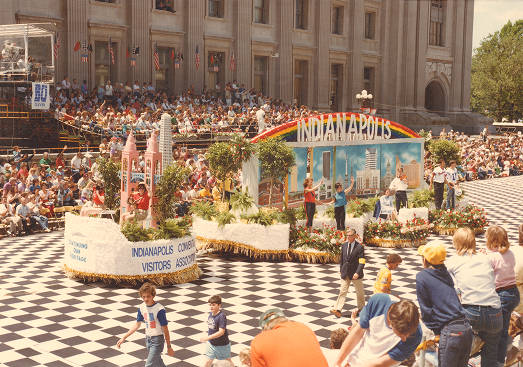Visit Indy is a nonprofit organization that serves as the official sales and marketing arm for the city of Indianapolis and the .

In 1923, local businessmen founded the Indianapolis Convention and Publicity Bureau (ICPB) in an effort to attract business from the fledgling convention industry to the city as part of the Indianapolis . Within its first nine months of operation, ICPB hosted 69 conventions with 36,125 delegates. The following year more than 67,000 people attended 201 conventions in Indianapolis, generating $11 million (about $166 million in 2020) in economic impact for the city. By 1932, conventions generated over $5 million (over $95 million in 2020) for Indianapolis’ economy.
ICPB spun off from the Chamber entirely by 1936 and was quickly renamed the Indianapolis Convention & Visitors Bureau (ICVB). By 1941, conventions were already becoming big business for Indy as a record 137,365 convention-goers attended 312 conventions in the city. During World War II, convention business dropped dramatically as the government discouraged all nonessential meetings. It increased after the war, however, and ICVB created a tourism department that featured group sightseeing tours of the city.
During the 1950s and 1960s, the convention industry continued to pump millions of dollars into the local economy. Tourism generated $7 million in 1950, $16 million by 1958, $20 million by 1961, and $36 million by 1968.
In 1965, the Indiana General Assembly created the to finance, build and operate the Indiana Convention Center. When this facility opened in downtown Indianapolis in 1972, it immediately increased the city’s capacity to host large meetings and events for the tourism industry. The building originally had 100,000 square feet of tradeshow space and Sammy Davis Jr. was the first performer in the venue.
Five years after the opening of the convention center, ICVB was reorganized. The bureau’s budget increased five-fold as it implemented a major marketing campaign. Revenues from conventions and tourism increased as well, jumping from $50 million in 1978 to $192 million just two years later in 1980.
In 1983, ICVB changed its name to the Indianapolis Convention and Visitors Association (ICVA). The following year the Indiana Convention Center went through its first expansion alongside the construction of the . By 1985, ICVA-related business had a $358.3 million impact on the local economy.
From the mid-1980s to the early 1990s, Indianapolis made rapid gains in convention business, soaring into the top third of convention cities based on bookings and economic impact. In 1993, a second Indiana Convention Center expansion was completed, which added more meeting space to the facility. By the end of this period, ICVA-related conventions and tourism claimed to generate over $1.2 billion for Indianapolis’ economy.
In 1999, , a nonprofit public relations arm for the city, was folded into ICVA. At the time of this merger, Indianapolis had become the 10th -largest convention city in the United States. To accommodate this growth in convention business, the Indiana Convention Center was expanded a third time between 2000 and 2001.
Throughout the 2000s and early 2010s, ICVA advocated for new and upgraded facilities to keep Indianapolis competitive in the convention and tourism industries. In 2005, the Indiana General Assembly passed legislation to finance what would become as well as another expansion of the convention center. Six years later, the fourth Indiana Convention Center expansion was completed, doubling its size and adjoining Lucas Oil Stadium (opened in 2008) via an underground connector. This $275 million investment brought the Indiana Convention Center and Lucas Oil Stadium to a combined total of 749,000 square feet of exhibition space.
The opening of the JW Marriott Hotel in downtown Indianapolis in 2011 also added needed accommodations for convention visitors. These projects contributed to the city’s winning bid for in 2012. Shortly after this event was held, USA Today named Indy the number one convention city in the United States, an accolade still held as of 2020.
Six months after Super Bowl XLVI, ICVA became Visit Indy. This new name was based on market research that showed people associated “Indy” as a more modern, cool, and desirable destination compared to perceptions connected to the city’s formal name.
Visit Indy’s mission is to increase Indianapolis’ growth by strategically selling the city to convention, meeting, event, and leisure travelers. Its work is largely funded through the Capital Improvement Board (CIB).
The organization’s most recent figures show Indianapolis welcoming 29.2 million annual visitors, who spend roughly $5.6 billion dollars in support of more than 82,900 full-time equivalent employment positions in the city’s hospitality industry. To attract new conventions, trade shows, corporate meetings, and related events in the future, CIB, Visit Indy, and other city leaders are planning a fifth major Indiana Convention Center expansion. The City-County Council approved the project in September 2020, and this work is scheduled to be completed in conjunction with the redevelopment of by the mid-to-late 2020s.
To finance this project, the city plans to issue up to $155 million in bonds that would be paid back through tax-increment financing (TIF) over 25 years. The two brand-new hotels on the Pan American Plaza site, meanwhile, will be privately funded by Kite Realty Group Trust.

Help improve this entry
Contribute information, offer corrections, suggest images.
You can also recommend new entries related to this topic.

